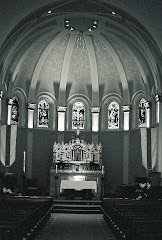My hope for this blog is that I can answer questions that people have. If you have any questions let me know. Here is the question I received today:
Today at Mass the altar server rang the bell. Do we have to ring the bells there? Why did that happen?
To answer liturgical questions we should go to the sources. The main source for how to do Liturgy is called "The General Instruction of the Roman Missal". This will be referred to as GIRM. The Original GIRM was written in the early 70s, but was recently updated in 2002. We get Liturgical answers from the 2002 GIRM.
#150 of the GIRM speaks about bells. It says: "A little before the consecration, when appropriate, a server rings a bell as a signal to the faithful. According to local custom, the server also rings the bell as the priest shows the host and then the chalice."
The phrase "When appropriate" is vague, and in the end lets it up to the priest. Some priests determine that every weekend Mass is appropriate, and others may determine it is never appropriate. My thinking is that it is appropriate at special times and seasons. By adding optional things during Special seasons shows that we are in a different time, and we recognize it is special. This is called: Progressive Solemnity.
A Little History:
Before the secon Vatican Council in the 1960s they used the bells at consecration at EVERY Mass. It reminded the people to adore the eucharist if they were doing other prayers. When the New Rite of Mass was introduced the bells were NOT mentioned in the new instructions. They were continued in some places and discontinued in others. It didn't say to do it, so people stopped doing it. It was NOT mentioned in the first GIRM at all. However, it is now mentioned again so some Churches are resuming the practice.
Enchanting the liturgy:
Bells add another dimension to the liturgy. The more sensory experiences we have to say: GOD is PRESENT, the better. Not only do we visibly see the Host and worship, when the bell is rung we can here the sign the God is present. This use of multiple senses, in a way adds new dimensions and enchants the liturgy. In education it is called multi-sensory learning.
I hope this answers your question.
peace
“Latin Mass Project” Seeks to Expand Knowledge of the Beauty of Tradition
-
I’ve been meaning to write about this for some time, and better late than
never. I encourage NLM readers to check out the initiative called the
“Latin Mass...
4 hours ago





I love the bells and wish we'd hear them every week!
ReplyDelete